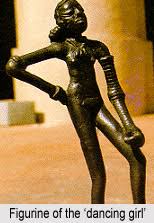Primary
evidence


 In any field it is important to take
into account all the evidence, especially evidence of a fundamental nature. This
can be illustrated with the help of what we now know about the Vedic river known
as the Sarasvati. The Rigveda describes the Sarasvati as the greatest and
the holiest of rivers — as ambitame, naditame, devitame (best of mothers,
best of rivers, best goddess). Satellite photographs as well as field
explorations by archaeologists, notably the great expedition led by the late
V.S. Wakankar, have shown that a great river answering to the description of the
Sarasvati in the Rigveda (flowing `from the mountains to the sea') did
indeed exist thousands of years ago. After many vicissitudes due to tectonic and
other changes, it dried up completely by 1900 BC. This raises a fundamental
question: how could the Aryans who are supposed to have arrived in India only in
1500 BC, and composed their Vedic hymns c. 1200 BC, have described and extolled
a river that had disappeared five hundred years earlier? In addition, numerous
Harappan sites have been found along the course of the now dry Sarasvati, which
further strengthens the Vedic-Harappan connection. As a result, the Indus (or
Harappan) Civilisation is more properly called the Indus-Sarasvati
Civilisation.
In any field it is important to take
into account all the evidence, especially evidence of a fundamental nature. This
can be illustrated with the help of what we now know about the Vedic river known
as the Sarasvati. The Rigveda describes the Sarasvati as the greatest and
the holiest of rivers — as ambitame, naditame, devitame (best of mothers,
best of rivers, best goddess). Satellite photographs as well as field
explorations by archaeologists, notably the great expedition led by the late
V.S. Wakankar, have shown that a great river answering to the description of the
Sarasvati in the Rigveda (flowing `from the mountains to the sea') did
indeed exist thousands of years ago. After many vicissitudes due to tectonic and
other changes, it dried up completely by 1900 BC. This raises a fundamental
question: how could the Aryans who are supposed to have arrived in India only in
1500 BC, and composed their Vedic hymns c. 1200 BC, have described and extolled
a river that had disappeared five hundred years earlier? In addition, numerous
Harappan sites have been found along the course of the now dry Sarasvati, which
further strengthens the Vedic-Harappan connection. As a result, the Indus (or
Harappan) Civilisation is more properly called the Indus-Sarasvati
Civilisation.

 The basic point of all this: we cannot
construct a theory focusing on a few relatively minor details like the
spoke-wheel while ignoring important, even monumental evidence like the
Sarasvati river and the oceanic symbolism that dominates the Rigveda.
(This shows that the Vedic people could not have come from a land-locked region
like Afghanistan or Central Asia). A historical theory, no less than a
scientific theory, must take into account all available evidence. No less
important, a man-made theory cannot take the place of primary evidence like the
Sarasvati river or the oceanic descriptions in the Rigveda. This brings
us back to Einstein — "A theory must not contradict empirical facts." Nor can it
ignore primary evidence.
The basic point of all this: we cannot
construct a theory focusing on a few relatively minor details like the
spoke-wheel while ignoring important, even monumental evidence like the
Sarasvati river and the oceanic symbolism that dominates the Rigveda.
(This shows that the Vedic people could not have come from a land-locked region
like Afghanistan or Central Asia). A historical theory, no less than a
scientific theory, must take into account all available evidence. No less
important, a man-made theory cannot take the place of primary evidence like the
Sarasvati river or the oceanic descriptions in the Rigveda. This brings
us back to Einstein — "A theory must not contradict empirical facts." Nor can it
ignore primary evidence.
harappa
archaeologyonline
http://www.thehindu.com/thehindu/op/2002/03/05/stories/2002030500130100.htm
harappa
archaeologyonline
http://www.thehindu.com/thehindu/op/2002/03/05/stories/2002030500130100.htm

No comments:
Post a Comment